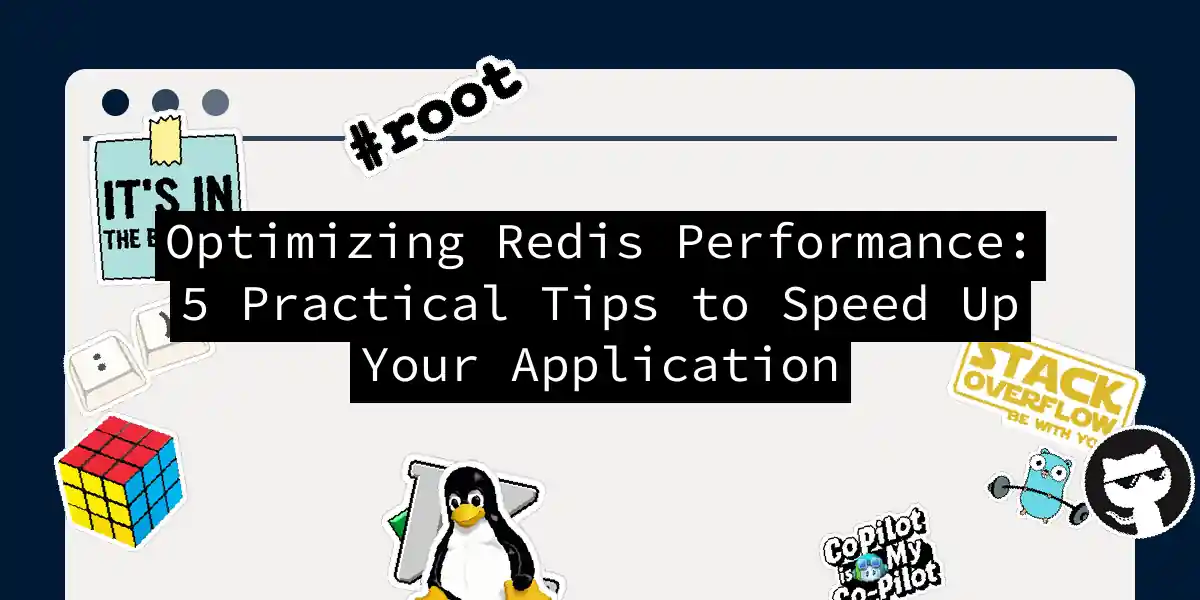Introduction to Redis Optimization
When it comes to building high-performance applications, Redis is often the go-to choice for its speed and versatility. However, even the fastest car needs a good mechanic to keep it running at peak performance. Here are five practical tips to help you optimize your Redis instance and ensure your application is running as smoothly as a well-oiled machine.
1. Pipelining Commands for Network Efficiency
Network latency can be a significant bottleneck in many environments. One of the most effective ways to mitigate this is by using Redis command pipelining. Pipelining allows you to send multiple commands to the Redis server without waiting for the responses, reducing the overall latency cost per operation.
Here’s an example of how you can use pipelining in Python:
import redis
# Create a Redis client
r = redis.Redis(host='localhost', port=6379, db=0)
# Create a pipeline
pipe = r.pipeline()
# Add commands to the pipeline
pipe.set('foo', 'bar')
pipe.get('foo')
# Execute the pipeline
pipe.execute()
2. Client-Side Caching
Client-side caching is another powerful technique to improve network efficiency. Introduced in Redis 6.0, client-side caching allows clients to cache keys and invalidate them when they change in Redis. This reduces the number of requests made to the Redis server, thereby improving performance.
Here’s how you can enable client-side caching in your Redis client:
import redis
# Create a Redis client with client-side caching enabled
r = redis.Redis(host='localhost', port=6379, db=0, track_changes=True)
# Set a key
r.set('foo', 'bar')
# Get the key (will be cached)
r.get('foo')
3. Configuring Persistence and Database Settings
Persistence Options
Redis offers two primary persistence options: RDB (Redis Database File) and AOF (Append-Only File). RDB performs point-in-time snapshots of your dataset at specified intervals, while AOF logs every write operation received by the server. You can choose one or both based on your application’s needs.
Here’s how you can configure these options in your Redis configuration file:
# RDB persistence
save 900 1
save 300 10
save 60 10000
# AOF persistence
appendonly yes
appendfilename "appendonly.aof"
Tuning Database Settings
By default, Redis configures 16 databases. If you don’t need multiple databases, reducing this number can help optimize performance.
# Reduce the number of databases
databases 1
4. Connection Management and Lua Scripting
Connection Management
Proper connection management is crucial for Redis performance. Ensure that connections are closed when no longer needed and consider using connection pooling to avoid the overhead of establishing new connections for each operation.
Here’s an example of using connection pooling in Python:
import redis
# Create a connection pool
pool = redis.ConnectionPool(host='localhost', port=6379, db=0)
# Get a connection from the pool
r = redis.Redis(connection_pool=pool)
# Use the connection
r.set('foo', 'bar')
r.get('foo')
Lua Scripting
Lua scripting allows you to run complex operations directly on the Redis server, reducing network round trips and enabling atomic operations. Here’s an example of a simple Lua script that increments a value:
local value = redis.call('get', KEYS[1])
value = tonumber(value)
if value == nil then
value = 0
end
return value + 1
You can execute this script using the EVAL command:
import redis
r = redis.Redis(host='localhost', port=6379, db=0)
script = """
local value = redis.call('get', KEYS[1])
value = tonumber(value)
if value == nil then
value = 0
end
return value + 1
"""
r.eval(script, 1, 'counter')
5. Sharding and Clustering for Horizontal Scalability
For high-demand environments, sharding your data across multiple Redis instances can significantly enhance performance and protect against data loss. Redis Cluster allows you to shard your data across several nodes.
Here’s an example of setting up a three-node Redis Cluster:
# Node 1
redis-cli -c -h 127.0.0.1 -p 7001 cluster addslots {0..5461}
# Node 2
redis-cli -c -h 127.0.0.1 -p 7002 cluster addslots {5462..10922}
# Node 3
redis-cli -c -h 127.0.0.1 -p 7003 cluster addslots {10923..16383}
Tuning Operating System Settings
Certain operating system settings can significantly impact Redis performance. For example, on Linux, you can adjust the vm.overcommit_memory and vm.swappiness kernel parameters.
# Relax memory checks
sysctl -w vm.overcommit_memory=1
# Reduce swap space usage
sysctl -w vm.swappiness=0
Advanced Memory Management
Efficient memory management is crucial for Redis performance. Here are a few strategies:
Configuring Memory Allocation
Set the maxmemory directive to specify the maximum amount of memory Redis should use.
maxmemory 2gb
Choosing the Right Eviction Policy
Select an appropriate eviction policy based on your application’s needs. Here’s an example of setting the allkeys-lru policy:
maxmemory-policy allkeys-lru
Case Study: Optimizing an E-commerce Platform
Let’s look at a real-world scenario where strategic Redis configuration adjustments led to significant performance improvements.
Problem
An e-commerce platform experienced slowdowns and frequent timeouts during peak sales events due to database overload.
Solution
The platform team implemented Redis to cache commonly accessed data such as product details and user sessions. Here are the tweaks they made:
- Max Memory Policy: Set to
allkeys-lruto prioritize caching recent and frequently accessed data. - Persistence Configuration: Used a combination of RDB snapshots and AOF with every write operation for data durability without performance trade-off.
- Connection Pooling: Adjusted
tcp-backlogandmaxclientsto handle sudden surges in user connections.
Results
By reducing direct database hits, the site’s response times improved by 50%, and timeout errors decreased significantly during high-traffic periods.
Conclusion
Optimizing Redis is not just about tweaking a few settings; it’s about understanding the intricacies of your application and tailoring your Redis configuration to meet those needs. By implementing these practical tips, you can significantly enhance the performance of your Redis instance and ensure your application runs smoothly and efficiently.
This sequence diagram illustrates the various optimization techniques discussed, showing how they interact between the application client, Redis server, and the underlying database. By implementing these strategies, you can ensure your Redis setup is optimized for high performance and reliability.
